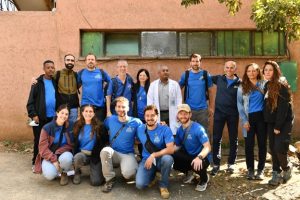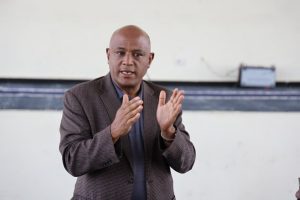
The worldwide advocacy for actions against climate change that has long been wedged by all “green actors and thinkers” has come of age bearing fruit of recognitions by the politicians and giving rise to real money making international business called Carbon Trading.
We are in a seemingly absurd time when strange scenarios are increasingly becoming real possibilities. For instance, a group of farmers in Ethiopia cover a barren section of their locality with forest and could get paid handsomely by a carbon emitting company somewhere in Europe or by an indigenous Airlines operator for the carbon emission reduction service their forest provided.
A study done recently in Africa reveals that a carbon trading afforestation enterprise for the multiple objectives of timber and carbon sequestration was found to be more profitable financially than the maize, beans and livestock enterprises. Afforestation projects on marginal and degraded agricultural lands could potentially contribute to improved livelihoods to farmers through enhanced financial inflows from carbon emission reduction revenue and sale of tree products while restoring and conserving the environment.
Carbon emission reduction projects are wide spectrum endeavors. Their scope stretch from renewable energy generation projects and production-process-optimization-technologies development to energy saving cook stoves projects and forest development. Afforestation projects are of particular interest to Africa as most of its populations’ livelihood is based on agriculture which is reckoned as the major sector of Green House Gas emissions, (GHG)
Higher temperatures, droughts, floods and unpredictable rainfall pattern, are the mascots of climate change. They indicate how quickly and drastically GHG are changing our planet. Such graphic examples, combined with the rising price of energy, drive people to want to reduce consumption and lower their personal shares of global emissions.
But behind the emotional front of climate change lies a developing framework of economic solutions to the problem. Two major market-based options exist, and politicians around the world have largely settled on Carbon Trading over its rival, Carbon Tax, as the chosen method to regulate GHG emissions.
Carbon trading, sometimes called emissions trading, is a market-based tool to control and limit GHG emissions. The carbon market trades emissions under cap-and-trade schemes or with credits that pay for or offset GHG reductions. Cap-and-trade schemes are the most popular way to regulate carbon dioxide (CO2) and other emissions. .
The Carbon Trading came about in response to the Kyoto Protocol. Signed in Kyoto, Japan, by some 180 countries in December 1997, the Kyoto Protocol called for 38 industrialized countries to reduce their greenhouse gas emissions. But because the Protocol does not manage the way in which members reduce their emissions, several mechanisms have arisen.
The largest and most famous is the European Union Emissions Trading Scheme (EU-ETS), which is in its phase 3 stage. It is a cornerstone of the EU’s policy to combat climate change and it is a key tool for reducing greenhouse gas emissions cost-effectively. It is the world’s first major carbon market and remains the biggest one. The EU ETS works on the ‘cap and trade’ principle. A cap is set on the total amount of certain greenhouse gases that can be emitted by installations covered by the system.
Within the cap, companies receive or buy Emission Allowances which they can trade with one another as needed. They can also buy limited amounts of International Credits from emission-saving projects around the world. After each year a company must surrender enough allowances to cover all its emissions, otherwise heavy fines are imposed.
International Carbon Credits are financial instruments that represent a tones of CO2 removed or reduced from the atmosphere as a result of an emissions reduction project. At present, international credits are generated through two mechanisms set up under the Kyoto Protocol One of thee which relevant to developing world like Africa is the Clean Development Mechanism (CDM) .
It allows industrialized countries with a greenhouse gas reduction commitment to invest in projects that reduce emissions in developing countries as an alternative to more expensive emissions reductions in their own countries. The Paris Agreement signed in 2016 established a new market mechanism to replace the CDM with NDC, Nationally Determined Contributions after 2020.
As the world’s largest carbon market, the EU ETS claims it is the biggest source of demand for international credits, making it the main driver of the international carbon market and the main provider of clean energy investment in developing countries and economies in transition. The aviation industry is projected to be another important sector with growing demand for international carbon credits.
International carbon markets can play a key role in reducing global greenhouse gas emissions cost-effectively. The number of emissions trading systems around the world is increasing. Besides the EU emissions trading system (EU ETS), national or sub-national systems are already operating or under development in Canada, China, Japan, New Zealand, South Korea, Switzerland and the United States.
Ethiopia aims to accomplish key economic goals while reducing GHG emissions through efforts that include carbon trading. Its Climate- Resilient-Green- Economy Strategy (CRGE) launched in 2012 underpins the country’s goal to become net carbon neutral by 2025. Experts estimate that such an accomplishment would involve the country in doubling its forest cover to around 30 percent of its landmass which makes it a daunting task.
The Ethiopian government has adopted and commenced the implementation of a UN initiative called REDD+[ Reducing Emissions from Deforestation and forest Degradation, and (+) the role of sustainable management of forests, conservation and enhancement of forest carbon stocks in developing countries ].
REDD+-Ethiopia considers carbon trading as financial tool as well as one of the benefits of the efforts being made towards implementing CRGE. So REDD+ can be taken as one of the instruments of CRGE being used to address the problems that the forest sector is facing presently. A country of a large expanse of deforested lands and degraded lands suitable for forest restoration, Ethiopia has a huge potential for REDD+ implementation resulting in accumulation of huge quantity of Carbon Credits that can be monetized in the Carbon market.
Ethiopia is no stranger to carbon trading, now it is trying to do it in huge scale by implementing REDD+. The Humbo Assisted Natural Regeneration project in south western Ethiopia was awarded in 2012 Africa’s first temporary Certified Emission Reductions, commonly called carbon credits with the World Bank as the primary client.
The project engaged seven community cooperatives in a natural land regeneration initiative. In less than four years, the project has restored 2,700 hectares of land in Ethiopia. Carbon payments are made to the community to invest in grain mills, storage and community infrastructure. The project has been a model for farmer-managed natural regeneration efforts in Niger, Chad and Burkina Faso.
Climate Change & Carbon Market Specialist at World Vision- Ethiopia, who had been assisting the Humbo farmers from outset of the project commented how the farmers’ views of the environment changed though the project: “Early in the process, during consultations we held with farmers in 2006, they would ask me ‘How can air be sold?’ Now they understand the process and are comfortable talking about carbon credits,” he said. “Our persistence in working as a partner with local communities and international institutions to solve real problems on the ground really paid off.”
Carbon Trading afforestation projects are a feasible income earning opportunity for farmers in Africa to diversify their agricultural enterprises and to get the most out of ,if any, their underutilized lands. However making a project qualified to get Carbon Credit is not an easy ride.
Policy and development agents at all levels should make sure that farmers get the required financial and technical supports to be effectively link to existing carbon markets. A policy environment that enables the necessary institutional mechanisms for community participation would be needed for the carbon trading afforestation contracts to work and bear fruits.
The Ethiopian Herald Sunday Edition 28 July 2019
BY SOLOMON WASSIHUN





